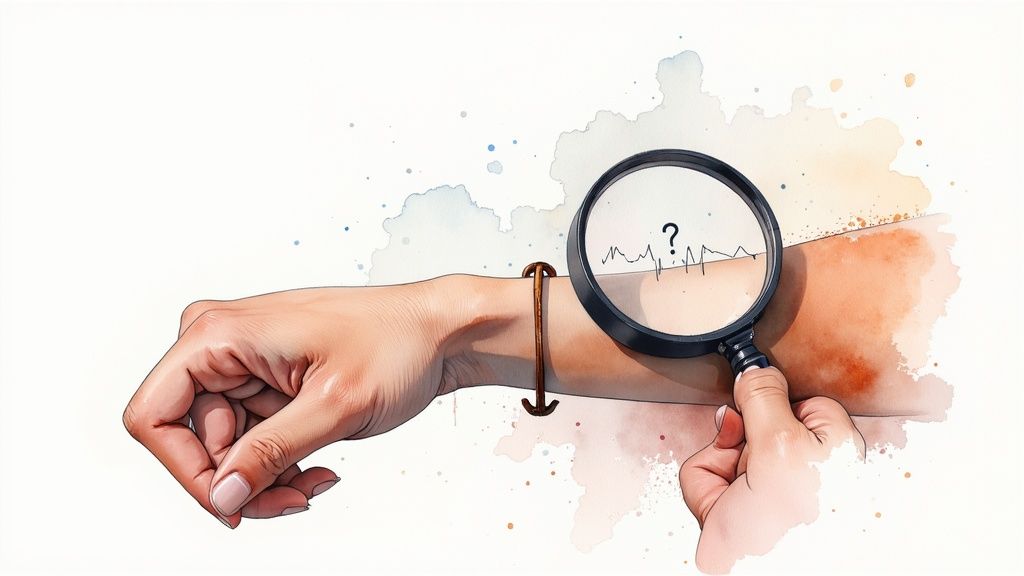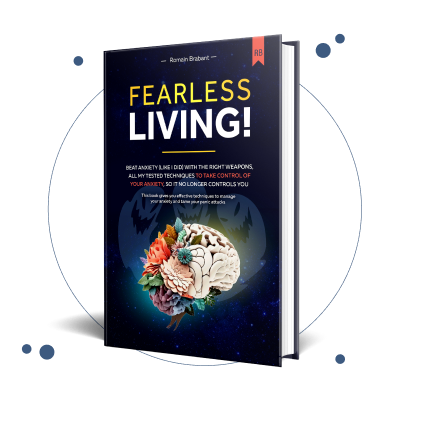
Overcoming health anxiety isn’t about ignoring your body or pretending you'll never get sick. It’s about discovering how to live peacefully with the natural uncertainties of being human, without letting fear run the show. This is a journey of healing, and it is absolutely possible to find lasting peace.
This is a journey from constant worry to proactive, calming strategies. You will learn to identify your anxiety triggers, challenge catastrophic thoughts, and gradually reclaim the joyful, full life you deserve. Hope is not just a feeling; it's a strategy, and your recovery starts now.
Your Path from Worry to Wellness Starts Now

If this feels familiar, you’re not alone. In 2023, 37% of people reported an increase in their anxiety levels from the year before. While these feelings are common, they absolutely do not have to control you. A peaceful, panic-free life is within your reach.
You can learn to dial down the fear and build a life where you feel safe and at home in your own body again. The first step is understanding what’s really going on inside your head, because with understanding comes the power to heal.
Understanding the Cycle of Fear
Health anxiety, sometimes called illness anxiety disorder, loves to trap you in a relentless loop. It starts small—a minor physical sensation, like a headache, a muscle twitch, or a weird stomach gurgle.
Instantly, an alarming thought pops into your head. That thought quickly spirals into a worst-case scenario, igniting intense fear and panic. Before you know it, you're deep-diving into "safety behaviors" like compulsively searching for symptoms online or repeatedly asking loved ones for reassurance.
While these actions might give you a moment of relief, they actually make the anxiety stronger. Each time you check and find nothing, your brain learns that checking is the only way to feel safe. This just makes the urge to check even more powerful the next time a strange sensation appears. But the hopeful truth is that any cycle can be broken.
The Health Anxiety Cycle vs. The Path to Recovery
Seeing the cycle laid out can be a real eye-opener. It helps you recognize the patterns you're stuck in and, more importantly, see the new, hopeful path you're about to create.
| The Anxiety Cycle | The Recovery Action |
|---|---|
| Trigger: A normal body sensation. | Action: Acknowledge the sensation without judgment. |
| Fear: Catastrophic thoughts spiral. | Action: Challenge the thought with logic and evidence. |
| Behavior: Compulsive checking/reassurance. | Action: Sit with the uncertainty and self-soothe. |
| Outcome: Temporary relief but stronger fear. | Action: Lasting confidence and reduced anxiety. |
This table isn't just a comparison; it's your roadmap to healing. Each "Recovery Action" is a skill you can and will develop, moving you out of the cycle and toward a calmer, more joyful state of being.
The core of health anxiety isn't a desire to be sick; it's a profound fear of illness and an intolerance of uncertainty. The goal isn't to ignore your health but to learn how to live peacefully within the natural uncertainties of having a human body. This is a skill, and like any skill, it can be learned.
A New Way Forward
Breaking this cycle requires a totally new approach. Instead of fighting the uncertainty, you’ll learn to sit with it. Rather than seeking constant reassurance from others, you’ll learn the profound skill of reassuring yourself.
This guide is designed to give you practical, actionable steps to dismantle the architecture of your fear, one piece at a time. It’s absolutely possible to feel safe, calm, and happy in your own body again. That healing journey starts right now.
Recognize the Subtle Signs of Health Anxiety

Before you can truly begin to heal from health anxiety, you have to see its fingerprints all over your daily life. It’s rarely as loud as a full-blown panic attack. More often, it's the quiet habits and hidden rituals that keep the fear cycle spinning, whispering that danger is always just one weird sensation away.
Think of this as a fact-finding mission, not a chance to judge yourself. This is the most empowering first step you can take—realizing that these behaviors are symptoms of anxiety, not signs of some personal failing. Once you see the pattern clearly, you gain the power to pull it apart, thread by thread, and weave something new.
Beyond Obvious Symptom Checking
Sure, compulsively checking a mole or monitoring your heart rate are classic signs. But health anxiety is sneakier than that. It often operates through what we call safety behaviors—little things you do to feel a quick hit of relief, but which actually end up making the anxiety stronger in the long run.
Do any of these feel familiar?
- Reassurance Seeking: This isn’t just one call to your doctor. It’s repeatedly asking your partner, "Do I look pale?" or texting a friend to describe a new ache, just waiting for them to say it’s nothing.
- Avoidance: Ever change the channel when a medical drama comes on? Or steer conversations away from friends discussing their health issues because it sets off your own alarms? That’s avoidance.
- Constant Research: Welcome to the "Dr. Google" spiral. It starts with a simple headache and ends hours later on a forum for the rarest, most terrifying condition imaginable.
- Hypervigilance: This is an intense, laser-like focus on your body. You notice every tiny gurgle, twitch, or twinge and immediately assign it a catastrophic meaning that someone without health anxiety would probably just ignore.
Anxiety is a massive global issue. Between 1990 and 2021, the prevalence of anxiety disorders shot up by an estimated 77%. But because of stigma and trouble accessing care, only about one in four people ever get any kind of mental health support. Knowing this helps put your own struggle into a much bigger context—you are not alone, and there is a well-trodden path toward healing.
Seeing the Spiral in Action
Let's play out a real-world scenario. You wake up with a mild, dull headache. For most people, that's just an annoyance. But if you're dealing with health anxiety, the inner monologue might sound more like this:
"This headache feels… different. It's not sharp, which is weird. I think I read somewhere that dull, persistent pain can be a sign of a brain tumor. I should probably cancel my weekend plans, just in case. Let me just do a quick search online for the symptoms…"
This isn't just an overreaction; it's a learned pattern, a well-worn groove in your brain. And the best news is that any pattern that’s learned can be unlearned. Identifying your specific triggers and safety behaviors is the key that unlocks your freedom.
If you're not sure where to begin, a structured quiz can help bring your symptoms into focus. You might want to explore a professional anxiety test to get a clearer picture of what you're experiencing.
Recognizing these subtle signs is a profound act of hope. It means you're becoming an observer of your anxiety instead of a victim to it. And that gives you the power to choose a different, more peaceful response.
How to Rewire Your Anxious Brain
Health anxiety turns your mind into a worst-case-scenario generator. It’s incredibly convincing, making every tiny sensation feel like a sign of imminent danger. But you can learn to talk back to that voice. This isn't about ignoring your thoughts; it’s about becoming a compassionate detective of your own mind to discover what's really true.
The process starts with a powerful tool called a thought record. Think of it less like a chore and more like a journal for healing. The goal is to catch a fear in the moment, look at it from all angles, and separate raw emotion from hard facts.
This practice literally retrains your brain, creating new, calmer neural pathways. Your anxious thoughts are like a well-worn trail in the woods—easy to follow because you've walked it so many times. A thought record helps you forge a new, more peaceful path toward a life free from panic.
Becoming a Thought Detective
When an anxious thought strikes, grab a notebook or a notes app and write it down. For example, your heart starts beating fast, and the immediate thought is: "This rapid heartbeat means I'm having a heart attack.”
Once it's on paper, you can start to question it like a kind, skeptical investigator. This is a core part of Cognitive Behavioral Therapy (CBT), one of the most effective treatments for anxiety. Understanding the basics of CBT gives you a solid framework for these exercises. For a deeper dive, you can learn more about how CBT helps with anxiety and see the science behind this strategy.
Now, ask yourself some powerful, evidence-based questions:
- What is the evidence for this thought? "My heart is beating fast."
- What is the evidence against this thought? "I've felt this before during anxious moments, and it always passed. I don't have other heart attack symptoms like chest pain. I just came out of a stressful meeting."
- What’s a more likely, less catastrophic explanation? "My body is having a normal stress response. The adrenaline is making my heart race, but it’s not dangerous."
- If a friend came to me with this exact thought, what would I tell them? "I'd tell them it sounds like a panic symptom, that they are safe, and that it will pass. I would encourage them to breathe deeply."
Finding Your Rational Voice
This process isn't about magical thinking. It’s about amplifying the calm, rational voice that anxiety constantly tries to drown out. It’s about shifting your perspective from automatic fear to thoughtful analysis.
Let's transform the original thought using the evidence you just gathered.
Original Thought: "This rapid heartbeat means I'm having a heart attack."
Balanced Reframe: "My heart is beating fast because I’m feeling anxious right now. I know from past experience that this is just a physical symptom of anxiety, and it will slow down as I start to calm myself."
At first, this reframed thought might not feel completely true. That’s okay, and it's totally normal. The real power is in the repetition.
Every time you consciously challenge an anxious thought and offer a balanced alternative, you weaken the grip of fear and strengthen your sense of hope. You are proving to yourself, one thought at a time, that you can navigate these feelings without spiraling. This is how you start to rewire your brain and show it a new, panic-free way to live.
Take Action with Behavioral Strategies That Work
Changing how you think is a huge part of the puzzle, but lasting freedom from health anxiety clicks into place when you start changing what you do. This is where you prove to your brain—through real, tangible experience—that you can handle discomfort and sit with uncertainty. It’s all about gently and intentionally stepping out of the cycle of avoidance and reassurance-seeking that keeps the fear alive.
The key is to start small. You're not going from zero to a hundred overnight. Instead, you'll build a personal "exposure hierarchy"—a series of small, manageable steps designed to build your confidence and retrain your nervous system from the ground up. This is a journey of courage, and every small step is a victory.
The infographic below shows the three core steps to rewiring those anxious thought patterns, which is the foundation you'll need before you can confidently take these behavioral steps.

This process shows that by consciously challenging a trigger and reframing it, you can stop the anxiety spiral before it gains momentum. That makes it so much easier to follow through with a different, more empowering behavior.
Create Your Personal Exposure Hierarchy
Think of an exposure hierarchy as your custom-made ladder for facing your fears. You'll list out all the situations that trigger you, from the least scary to the absolute most terrifying, and then you'll start climbing, one rung at a time. This method is a core part of https://anxietychecklist.com/exposure-therapy-anxiety, a powerfully effective approach that puts you back in control by showing you that your feared outcomes rarely, if ever, actually happen.
Here’s how you can build your own:
- List Your Safety Behaviors: What do you do to get that instant hit of relief? Do you google symptoms for hours? Constantly check your body for lumps, bumps, or changes? Avoid medical shows like the plague? Jot them all down.
- Rank Them by Difficulty: Give each behavior a score from 1 (a little challenging, but I could probably do it) to 10 (absolutely terrifying).
- Start at the Bottom: Pick a task with a low score. You want something that feels like a stretch, but is still totally doable.
Putting It Into Practice
So, what does this actually look like? Remember, this isn't about being reckless with your health. It’s about chipping away at the compulsive, anxiety-fueled behaviors.
- If you constantly check your body: Your first step could be to simply delay the check. When the urge hits, set a timer for five minutes. The goal isn’t to never check again (at least not yet), but to prove you can tolerate the urge to do it right now.
- If you avoid reading about health: Your first experiment might be to read a single health-related headline without clicking on the article. That's it. Just see the words, feel the discomfort, and let it pass.
- If you seek constant reassurance: Challenge yourself to wait one hour before asking a loved one about a symptom. Use that hour to try out some self-soothing techniques you've learned instead.
Each small win, no matter how minor it seems, is a powerful message of hope to your brain. You are teaching it: "I felt the fear, I did the hard thing anyway, and I survived. I am far more capable than my anxiety gives me credit for."
This process slowly retrains your nervous system. Through lived experience, it shows you that you don't actually need these rituals to stay safe.
For more specific techniques to manage those immediate feelings of panic, this guide to coping with anxiety and depression offers practical strategies that work beautifully alongside the behavioral changes you're making. And above all, remember to be patient and compassionate with yourself. This is a practice, not a performance, and every step forward is a step toward freedom.
Build a Resilient Lifestyle and Prevent Relapse
Getting a handle on health anxiety isn't just about managing panic when it strikes; it’s about building a life that naturally keeps your mind on solid ground. This is where the real work—and the real hope—begins. You move from constantly reacting to anxiety to proactively creating a foundation that makes it much harder for those old fears to find a foothold.
It's about weaving small, sustainable habits into your day that act as a buffer against stress. This isn't some rigid, punishing regimen. Think of it as a compassionate way to care for your mind and body, making both of them more resilient and ready for a life of peace.
Pillars of a Panic-Free Life
Building this kind of resilience means focusing on a few key areas that have an outsized impact on your nervous system. These aren't quick fixes, but they are long-term investments in your own peace of mind, and they truly work.
-
Mindful Movement: Getting your body moving is one of the most powerful things you can do for anxiety. It helps burn off the excess adrenaline and cortisol—those pesky stress hormones that keep your fight-or-flight system on high alert. Even a 20-minute walk or a simple stretching routine can dial things down. Making consistent physical activity a part of your life is a game-changer; you can find some great advice on how to start working out at home if you're not sure where to begin.
-
Nourishing Your Brain: What you eat has a direct line to how you feel. A diet heavy on processed foods and sugar can fuel inflammation and mood swings. On the flip side, whole foods packed with omega-3s, magnesium, and B vitamins support brain health and help keep your mood stable. You're literally fueling your mind for calmness.
-
Prioritizing Rest: Sleep is when your brain hits the reset button and processes emotions. Skimp on quality sleep, and you’re leaving yourself wide open to anxious thoughts. A calming bedtime routine can signal to your body that it's safe to wind down, dramatically improving both how long and how well you rest.
Creating Your Relapse Prevention Plan
Look, even with the best habits, tough days are going to happen. A relapse prevention plan is your personal roadmap for navigating those moments with confidence instead of falling back into fear. It puts you back in the driver's seat by turning a potential crisis into a manageable bump in the road.
Think of your plan as a compassionate tool, not a weapon to beat yourself up with. Recovery isn't a straight line. This plan acknowledges the ups and downs and prepares you to handle them with skill and hope.
First, get clear on your personal early warning signs. These are the subtle little shifts in your thoughts or behaviors that signal anxiety is creeping back.
Maybe it's things like:
- Checking your body for odd sensations more often.
- Feeling that familiar pull to Google a symptom.
- Asking a loved one for reassurance "just one more time."
Next, for each warning sign, you're going to map out a healthy, pre-planned response. This takes the guesswork out of what to do when you're already feeling stressed.
| Warning Sign | Pre-Planned Action |
|---|---|
| Urge to Google symptoms | Close the laptop. Call a friend to talk about their day for 10 minutes. |
| Increased body-checking | Acknowledge the urge without judgment. Do a 5-minute guided meditation. |
| Seeking reassurance | Write down the specific fear. Then, write down one balanced, rational thought to counter it. |
Taking this proactive approach is the ultimate act of self-empowerment. It's a declaration that you have the tools, you have a plan, and you can absolutely live a full, joyful, and panic-free life.
Got Questions About Health Anxiety? Let's Talk.
As you start untangling yourself from health anxiety, you're going to have questions. That's a great sign. It means you’re getting curious, digging deeper, and really engaging with the process of getting better.
Here are a few of the most common questions I hear, along with some straight-up answers to keep you moving forward with hope.
Can You Ever Really "Cure" Health Anxiety?
I get this one a lot. While "cure" isn't quite the right word, reaching a place where anxiety no longer runs your life is 100% possible. People recover from this all the time, and you can too.
The goal isn't to magically erase every single anxious thought for the rest of time. It's about building the skills to manage them so effectively they lose their power. Think of it like learning to drive; at first, it takes all your focus, but eventually, it becomes second nature. You learn to spot an anxious thought, understand why it’s popping up, and respond calmly—which strips it of its power.
For most people who do the work, health anxiety becomes a quiet echo from their past. It’s no longer the loud, demanding voice that dictates their every move. They get their lives back, fully and confidently, without that constant weight of fear. A life free from panic is not a fantasy; it's a realistic and achievable goal.
Freedom isn’t the absence of anxious thoughts. It’s knowing they have no power over you. Recovery means you are back in the driver’s seat of your life.
Should I Try to Handle This on My Own or See a Professional?
This is a really personal decision, but here’s a good way to frame it. If your anxiety is seriously getting in the way of your work, your relationships, or just your ability to enjoy a single day, then finding a therapist who specializes in Cognitive Behavioral Therapy (CBT) is one of the best and most hopeful moves you can make. They can give you a clear, evidence-based roadmap to get you where you want to go.
That said, if your symptoms feel a bit more manageable, the self-help strategies in this guide can make a huge difference. Lots of people make incredible progress on their own.
But remember, there's zero shame in asking for help. It's a sign of strength. If you feel like you're spinning your wheels, knowing when to get professional help is often the fastest way to feel better and take back control.
What's the Difference Between Normal Health Concerns and Health Anxiety?
This is such a crucial question. The line can feel blurry, but it’s actually pretty clear.
A normal health concern is proportional. You get a weird cough that won't go away, you see a doctor, you follow their advice, and you move on with your life. It leads to a productive action, and then it's over.
Health anxiety is a whole different beast. It's excessive, obsessive, and it just won't let go, even after multiple doctors have given you the all-clear. It’s about interpreting completely normal bodily sensations—a muscle twitch, a stomach gurgle, a slight headache—as a sign of a terminal illness.
The real difference? The devastating impact it has on your daily life. Normal concern is a blip on the radar; health anxiety hijacks the entire system. But the most important thing to remember is that it doesn't have to be this way. There is a clear path to healing, and you have already taken the first step by being here.

